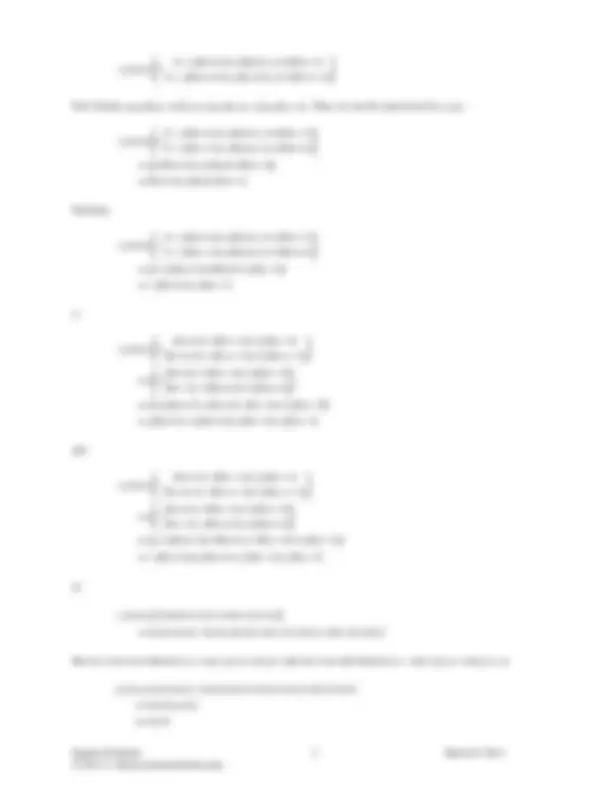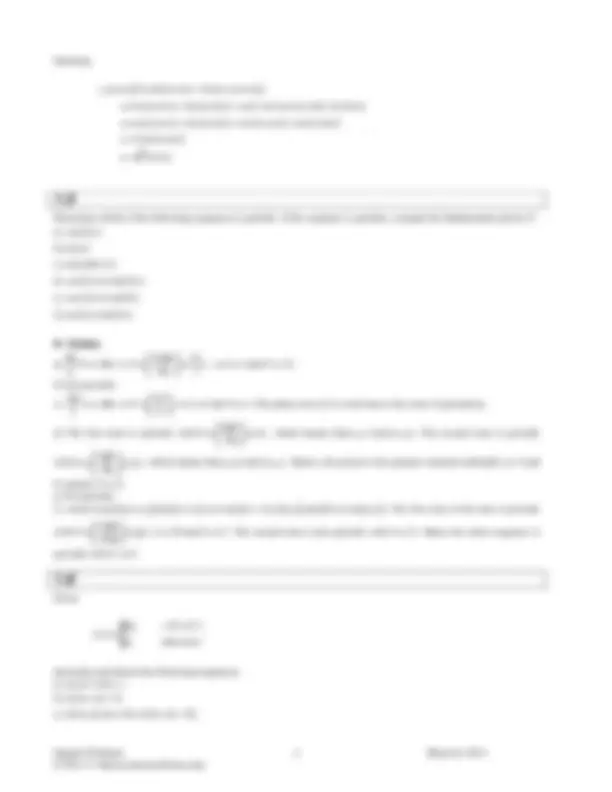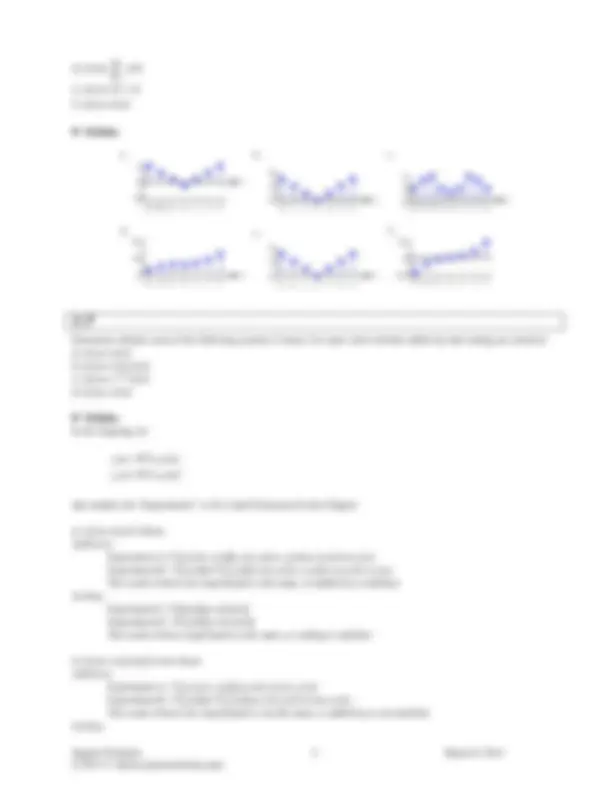





Study with the several resources on Docsity

Earn points by helping other students or get them with a premium plan


Prepare for your exams
Study with the several resources on Docsity

Earn points to download
Earn points by helping other students or get them with a premium plan
Community
Ask the community for help and clear up your study doubts
Discover the best universities in your country according to Docsity users
Free resources
Download our free guides on studying techniques, anxiety management strategies, and thesis advice from Docsity tutors
Digital Signal processing homework two
Typology: Exercises
1 / 6

This page cannot be seen from the preview
Don't miss anything!




Signals Problems March 9, 2014 1
Given x n [ ] shown below, sketch the following a) x [1 − n ] b) x n [ −1] c) x [2 n +1] d) x [1 −2 ] n
3 0 1 2 3 4
0
1
2
n
x n [ ]
► Solution:
0 1 2 3 4 5
0
1 2
a)
3 2 1 0 1 2 3 4 5 2
1
0
1 2
b)
(^22 1 ) 1
0
1 2
c)
(^21 0 1 ) 1
0
1 2
d)
n
n n
n
For each of the following sequences, find and plot (^) xe [ ] n and (^) xo [ ] n.
0 1 2 3
0 1 2 3
0
2
a)
2
0
2
b)
4 3 2 1 0 1
2
0
2
c)
1
2
3
[ ]
[ ]
[ ]
x n
x n
x n
n
n
n
► Solution:
Signals Problems March 9, 2014 2
0 1 2 3
0
1
2 a)
3 2 1 0 1 2 3
1
0
1
2
3 2 1 0 1 2 3
2
1 0 1 2
b)
3 2 1 0 1 2 3
2
1 0 1 2
4 3 2 1 0 1 2 3 4
1
0
1
2
c)
4 3 2 1 0 1 2 3 4
1
0
1
2
n
n
n n
n
n
1 1
2 2
3 3
[ ] [ ]
[ ] [ ]
[ ] [ ]
e o
e o
e o
x n x n
x n x n
x n x n
► Solution:
For each of the following sequences, find (^) xe [ ] n and (^) xo [ ] n. a) (^) x n [ ] = 1 + ej^^4 π n b) (^) x n [ ] = (1 − j ) [ δ n + 1] + j δ[ ] n + ( j + 1) [δ n −1] c) (^) x n [ ] = δ[ n +1] − 2 [δ n −1] + 2 j δ[ n −2] d) x n [ ] = 2sin( 4 π n + 3 π)
► Solution: a)
4 4 4 4
(^12 ) (^12 )
[ ] 1 1 1 cos [ ] 1 1 sin
e^ j^ n^ j^ n j n j n o
x n e e n x n e e j n
π π
π π
π π
− −
b)
Signals Problems March 9, 2014 4
Similarly,
4 3 4 3 4 3 4 3 4 3 4 3 4 3 4 3 4 3 4
[ ] 2 cos( ) 2 cos( ) cos cos sin sin cos( ) cos sin( ) sin cos cos sin sin cos cos sin sin 2sin sin 3 sin
x o n n n n n n n n n n n n n
π π π π π π π π π π π π π π π π π π π π π π π
Determine which of the following sequences is periodic. If the sequence is periodic, compute the fundamental period, N. a) cos( 311 π n ) b) cos( ) n
d) cos( 73 π n ) +sin( 52 π n ) e) cos( 73 π^ n ) +sin(5 ) n f) cos( 73 π n ) sin( 52 π n )
► Solution:
a) 3 2 22 22 11 3 3
, so^ k^ =^3 and^ N^ =^22.
b) Not periodic
c) 5 2 4 2 5
, so^ k^ =^5 and^ N^ =^4 .The phase term (2) is irrelevant to the issue of periodicity.
d) The first term is periodic with (^667) 7
, which means that^ k^ =^7 and^ N^ =^6. The second term is periodic
with (^445) 5
, which means that^ k^ =^5 and^ N^ =^4. Hence, the period is the greatest common multiplier or 4 and
6, namely N = 12. e) Not periodic.
with (^121029) 29
,^ k^ =^29 and^ N^ =^12. The second term is also periodic with^ N^ =^12. Hence the entire sequence is
periodic with N = 12.
Given
, 3 3 ( ) 0, otherwise
n n x n
determine and sketch the following sequences: a) y n [ ] = 2 [ ] x n − 1 b) y n [ ] = x n [ −3] c) y n [ ] = (^13) ( x n [ + 1] + x n [ ] + x n [ −1])
Signals Problems March 9, 2014 5
d) [ ] [ ]
n k
y n x k =−∞
= (^) ∑
e) y n [ ] = x [2 − n ] f) y n [ ] = nx n [ ]
► Solution:
0 1 2 3
0
5
a)
0 1 2 3 4 5 6 0
2
4
b)
(^04 3 2 1 0 1 2 3 )
1
2
c)
(^03 2 1 0 1 2 )
10
20
d)
1 0 1 2 3 4 5 0
2
4
e)
(^103 2 1 0 1 2 )
0
10
f)
n
n
n
n
n
Determine whether each of the following systems is linear. For each, show whether additivity and scaling are satisfied. a) y n [ ] = nx n [ ] b) y n [ ] =cos (^) ( x n [ ]) c) y n [ ] = e j^^ ω x n [^ ] u n [ ] d) y n [ ] = x [2 ] n
► Solution: In the forgoing, let
1 1 2 2
y n T x n y n T x n
and conduct the “Experiments” A, B, C and D discussed in the Chapter.
a) y n [ ] = nx n [ ]is linear. Additivity : Experiment A: T (^) { x n 1 [ ] + x 2 (^) [ ] n (^) } = n x n ( 1 [ ] + x 2 (^) [ ] n (^) ) = nx n 1 [ ] + nx 2 [ ] n Experiment B: T (^) { x 1 (^) [ ] n (^) } + T (^) { x 2 (^) [ ] n (^) } = n x n ( 1 [ ] + x 2 (^) [ ] n (^) ) = nx n 1 [ ] + nx 2 [ ] n. The result of these two experiments is the same, so additivity is satisfied. Scaling : Experiment C: T (^) { kx n [ ] (^) } = n kx n ( [ ]) Experiment D: kT (^) { x n [ ] (^) } = k nx n ( [ ]) The result of these experiments is the same, so scaling is satisfied.
b) y n [ ] = cos (^) ( x n [ ])is non-linear. Additivity : Experiment A: T (^) { x 1 (^) [ ] n + x 2 (^) [ ] n (^) } = cos (^) ( x n 1 [ ] + x 2 [ ] n ) Experiment B: T (^) { x n 1 [ ] (^) } + T (^) { x 2 (^) [ ] n (^) } = cos( x n 1 [ ]) + cos( x 2 [ ]) n. The result of these two experiments is not the same, so additivity is not satisfied. Scaling :